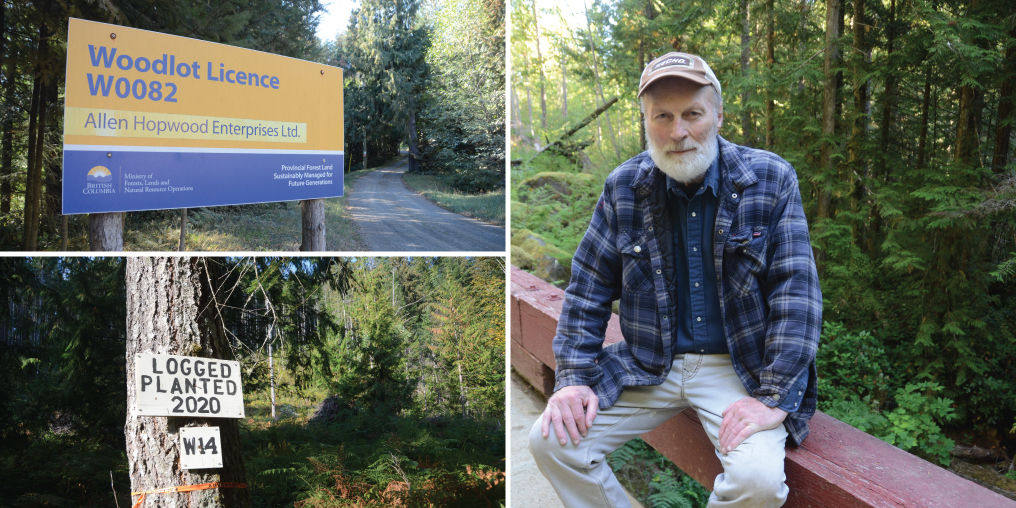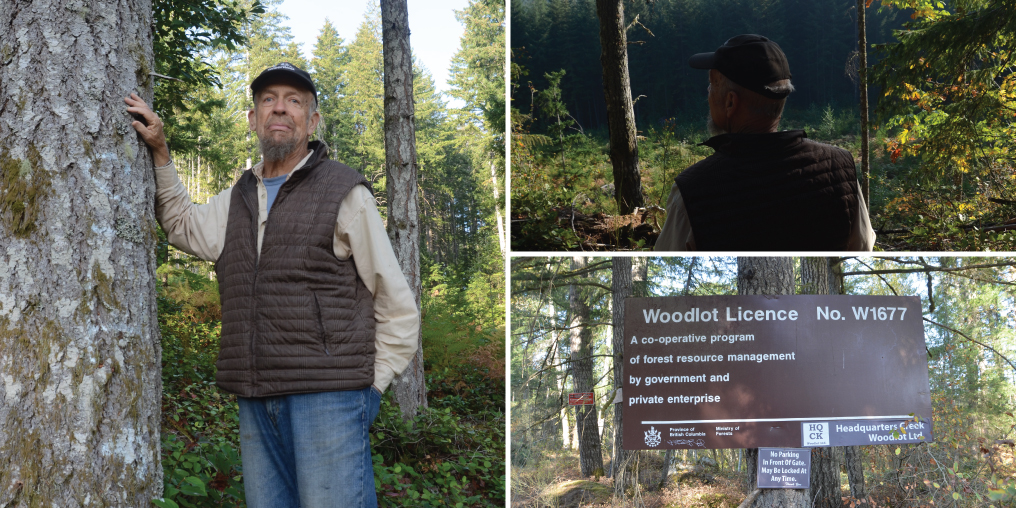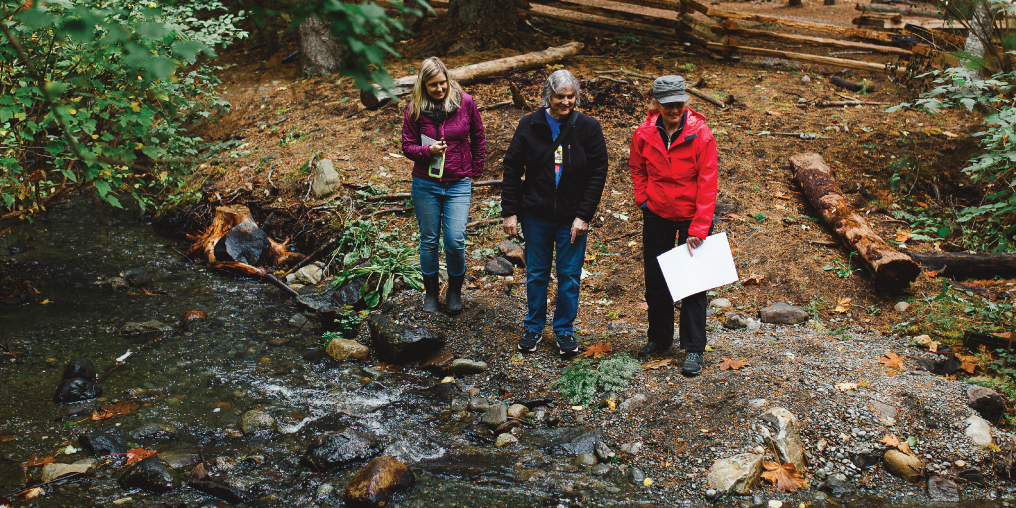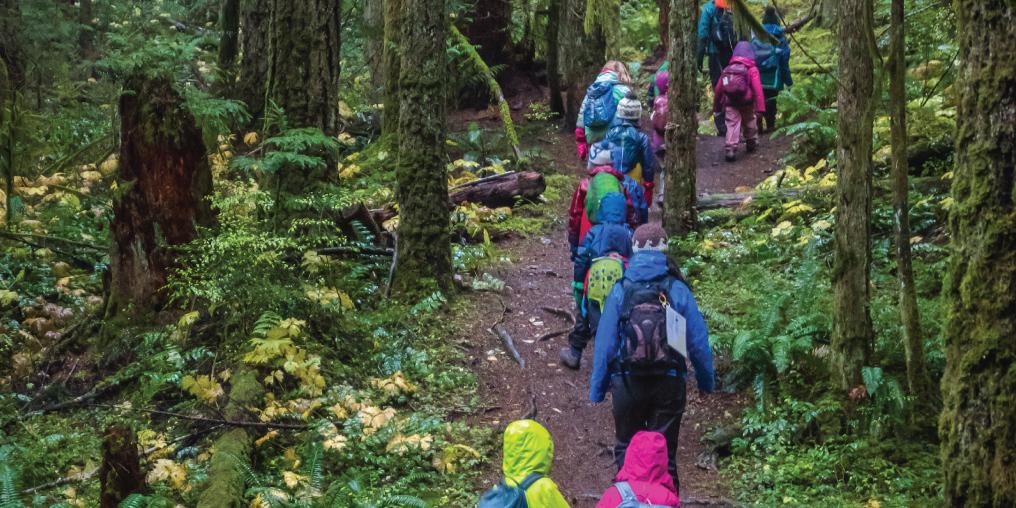There are two basic ways to look at a forest you manage—as a tree farm or an ecosystem.
To see the difference, stand on the edge of Al Hopwood’s woodlot on the lower slopes of Forbidden Plateau. On his side of the line is a multi-aged stand of century-old Douglas fir, with younger western red cedars flourishing in the understory. On the other side—land owned by TimberWest and managed by Mosaic Forest Management—is a dense wall of homogenous western hemlocks as thick as weeds.
Hopwood is no tree hugger. He’s a professional forester who manages trees that will be cut down, bucked into logs, and sawn into telephone poles, flooring, two-by-fours, and countless other products. But that’s where the similarities between him and his neighbour, TimberWest, the largest private forest landowner on Vancouver Island, end. When Hopwood walks through his forest, he walks through a landscape he knows intimately—right down to the individual Douglas fir.
In the late 1980s, when Hopwood was working as a forestry consultant and living in Brentwood Bay, he started looking for forest land he could afford. His search eventually led him to a 34-hectare parcel next to the first switchback on Forbidden Plateau Road. The land was adjacent to nearly 100 hectares of Crown land, a rarity in the Comox Valley.
Hopwood asked the provincial government if it would make the land available as a woodlot. The province has three basic criteria for awarding woodlots: personal suitability and experience; private land that can be managed together with Crown land in accordance with provincial forestry regulations; and management intent. Hopwood easily met the first two criteria, but government bureaucrats tripped on the third.
“At first, they didn’t like my plan. They wanted me to clearcut to get rid of laminated root rot,” Hopwood says, about the government’s aggressive ideas for dealing with a fungus that was damaging Douglas fir trees.
Hopwood’s forest management plan involved doing something different. He wanted to use a mix of harvesting techniques, from patch cuts—small openings—to group and single-tree selection, which would target trees infected with laminated root rot and allow the growth of a diverse-aged forest of mostly fir and cedar. The goal was simple on paper: to increase the amount of valuable forest (“valuable,” for Hopwood, means of a quality that can be sold on the log market) as time went by.
“I told them I’m either doing it my way or they can take the woodlot back,” Hopwood says. It took two years of discussions, but he finally got his plan approved. He started building roads and did his first cut in 1998.
On a fall morning way too warm for early October, I meet Hopwood for a walk in the woods. Supply Creek, which runs through the woodlot, is dry as a desert, but the stand of firs, some with two-foot butts, looks tall and healthy on the moisture-receiving flats at the toe of the hill. An old steam donkey, a relic of the past, lies on the forest floor, half buried in electric green moss.
Spend enough time in a forest and you get to know it. As I walk with Hopwood, he tells me about the underlying bedrock; the soil depth; where the nutrient-rich and nutrient-poor sites are located; where water seeps from springs; the trees favoured by the threatened Queen Charlotte goshawks for nest sites; and the massive Sayward forest fire of 1938 that was stopped by the Brown’s River, sparing this forest. He also knows some of the human history of this place. In the early 19th century, Thomas Gwilt used this steam donkey—a steam-powered engine—to skid logs from what is today Hopwood’s woodlot down to the Puntledge River. From there, the logs were floated downriver to Gwilt’s sawmill in Bevan townsite, a mill destroyed by fire in 1925.
Over the years, Hopwood has kept meticulous inventories on his woodlot. By his calculations, in 1994 there were 352 cubic metres/hectare of merchantable timber on his woodlot (a cubic metre is equal to a telephone pole’s worth of wood). In 2018, after 25 years of logging, there were 426 cubic metres/hectare.
“That was my goal. To increase the timber value on this woodlot,” he says.
Hopwood’s policy has always been no locked gates—a marked contrast to the tightly controlled access on Mosaic lands. If people check in with Hopwood, they’re welcome. Hikers, mountain bikers, mushroom pickers, and birdwatchers all pass through his woodlot from time to time, and he’s comfortable with that, as long as they don’t conflict with harvesting or other woodlot operations.

Harold Macy applies the same policy to his woodlot. In fact, over the years, Macy has welcomed more than a thousand schoolkids and others wanting to learn more about forestry, forest ecology, and woodlot operations.
Macy is a product of the 1960s hippie counterculture movement who grew up in a Quaker family in Kansas before immigrating to Canada. Thinking outside the box is in his DNA. His career path eventually led him to UBC’s Oyster River Research Farm, where he taught courses on non-timber forest products (like wild mushrooms, berries, and salal) and woodlot management.
In 1998, a year before UBC closed the research farm, Macy acquired a tenure for a 250-hectare woodlot at the foot of the Strathcona Parkway. It was a fantastic opportunity. Unlike Hopwood, who had had to fight entrenched views of what forestry should look like, the government asked Macy to showcase other approaches to forest management.
“The province wanted a demonstration forest, to show that things could be done differently,” Macy recalls.
By “differently,” he means a type of forestry with a much lighter and more thoughtful touch than status-quo industrial clearcut logging. For Macy, forest management is as much a spiritual pursuit as it is a financial one. That’s why he often comes to the woodlot to sit at one of his favourite places, a makeshift wooden bench perched atop a mossy granite escarpment.
According to Macy, it takes a decade or so to truly know and understand a forest. “I suppose it’s a form of meditation,” he says. “They’re complex ecosystems. I’ve learned more out here in the forest than I ever have in a classroom.”
And this woodlot is deeply personal to him. It’s like family. His four sons, three of whom became foresters, have all driven skidders and planted trees here. Even his grandkids have planted a few fir and cedar seedlings over the years. But it’s also a business, a family-supporting business. Macy has harvested, on average, 48 truckloads of logs annually, and made more than half of his living from the woodlot in his 25 years of managing it.
“This is not hobby forestry. It’s sustainable, viable forestry,” he says. “I take my role seriously as a steward of this piece of creation.”
These days, Macy, at age 76, spends more time writing than walking in the woods. He has authored a novel, a short-story collection and a handbook called The Four Storey Forest, which chronicles his approach and experiences on the family woodlot. He survived a bout with cancer, but now struggles with Parkinson’s disease, an affliction that makes it difficult to walk through slash and across the uneven forest floor. One of his current projects is growing Garry oaks. The Comox Valley is near the northern extent of the Garry oak’s natural habitat. On a small patch of well-drained land in the woodlot, he’s planted 100 acorns collected from a grove of these beautiful hardwoods on Mission Hill.
“I wanted to help preserve this species and keep this genetic resource viable,” he says, adding that the acorns have yielded 30 juvenile Garry oaks so far.
Though Macy is stepping away from day-to-day forest management, the woodlot is staying in the family: his son Benjamin, who owns Oceanside Forest Consulting in Parksville, has stepped into the role of woodlot manager.

Besides a fondness for forests, Macy and Hopwood share something else—a way of speaking that’s direct, even blunt at times, but tempered with a thoughtfulness born from experience. Hopwood is also nearing retirement. Recently he decided not to renew his woodlot license and focus on managing his privately owned forest, which, up until recently, he managed as part of the woodlot (one of the key requirements for obtaining a Crown woodlot license.)
“I think I’ve done what I set out to do,” Hopwood says. “The people in Victoria who manage the woodlot program don’t understand what we do, they don’t really champion it.”
But they should. In fact, they should tell the world about it.
ABOUT WOODLOTS
The BC government introduced the current woodlot license system in 1979. Tenure is awarded for 20 years and can be renewed given that the conditions of agreement are being met, which in big-picture terms are to sustainably manage the forest for its timber and ecological values on behalf of British Columbians. There are roughly 850 woodlots in BC totalling 600,000 hectares, 10 per cent of which is private land.
To put this into perspective, woodlots account for just 1.4 per cent of the provincial Annual Allowable Cut (AAC), the number that the province deems is the sustainable level of harvesting per year. Most Crown forest tenures are allocated in the form of a tree farm license (TFL), a massive area of public land awarded to large timber companies. For example, Western Forest Products’ TFL 39 consists of 360,000 hectares across four locations around northeastern Vancouver Island and the mainland coast.





